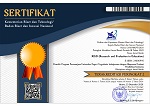The characteristics of chemistry test items on nationally-standardized school examination in Yogyakarta City
Heri Retnawati, Universitas Negeri Yogyakarta, Indonesia
Deni Hadiana, Center for Assessment and Learning of the Ministry of Education and Culture, Indonesia
Pujiastuti Pujiastuti, Sekolah Menengah Atas Negeri 7 Yogyakarta, Indonesia
Eri Yusron, Universitas Negeri Yogyakarta, Indonesia
Abstract
This study aimed to describe the characteristics of chemistry test items in Nationally Standardized School Examination or Ujian Sekolah Berstandar Nasional (USBN), consisted of discrimination index, difficulty index, and question reliability. The data were collected by using documentation of the answers of 194 students. The type of research was descriptive exploratory with quantitative and qualitative approaches. Quantitative data analysis was performed by using the classical test theory approach and item response theory with 1 logistical parameter. Meanwhile, qualitative data analysis was conducted to describe the items categorized as difficult and bad categories. The results show that, according to classical test theory, the USBN Chemistry item test has an average level of difficulty of 0.57, which is categorized as moderate. Regarding the discrimination index, the average of different test power obtained is equal to 0.146 and belongs to the good category. Based on the item response theory, the average difficulty index of -0.00086 is categorized as moderate. The results of the estimated reliability of the questions amounted to 0.48 is included in the moderate category. The results of the qualitative analysis show that the items which belong to the difficult category are the items on salt hydrolysis material, acid-base titration, the concept of periodicity, manufacture, and use of chemical compounds according to classical test theory. Meanwhile, according to the theory of response, items that belong to the difficult category were found in acid-base titration material, the colligative solution phenomenon, and the concept of periodicity of the main metal elements.
Keywords
Full Text:
PDFReferences
Akbar, S. A. (2016). Desain didaktis pembelajaran hidrolisis didasarkan hasil refleksi diri guru melalui Lesson Analysis. Jurnal Edukasi Kimia, 1(1), 6–11. http://ojs.serambimekkah.ac.id/JEK/article/view/161
Ariani, L. H. D., Maimunah, M., & Roza, Y. (2019). Analisis kesalahan siswa dalam menyelesaikan soal USBN matematika SMA. EduMath, 8(1), 42–48. https://ejournal.stkipjb.ac.id/index.php/math/article/view/1117
Arjoon, J. A., Xu, X., & Lewis, J. E. (2013). Understanding the state of the art for measurement in chemistry education research: Examining the psychometric evidence. Journal of Chemical Education, 90(5), 536–545. https://doi.org/10.1021/ed3002013
Azwar, S. (2008). Reliabilitas dan validitas. Pustaka Pelajar.
Dirgahayuning, A. (2017). Penerapan strategi pembelajaran aktif learning start with question untuk mencapai ketuntasan belajar siswa pada pokok bahasan termokimia kelas XI IPA 6 SMA Negeri 5 Pekanbaru. Perspektif Pendidikan Dan Keguruan, 8(2), 13–20. Retrieved from https://journal.uir.ac.id/index.php/Perspektif/article/view/775
Fitriani, W., Hairida, H., & Lestari, I. (2014). Deskripsi literasi sains siswa dalam model inkuiri pada materi laju reaksi di SMAN 9 Pontianak. Jurnal Pendidikan Dan Pembelajaran, 3(1), 1-13. https://jurnal.untan.ac.id/index.php/jpdpb/article/view/4432
Herkusumo, A. P. (2011). Penyetaraan (equating) ujian akhir sekolah berstandar nasional (UASBN) dengan teori tes klasik. Jurnal Pendidikan Dan Kebudayaan, 17(4), 455-471. https://doi.org/10.24832/jpnk.v17i4.41
Indriani, A., Suryadharma, I. B., & Yahmin , Y. (2017). Identifikasi kesulitan peserta didik dalam memahami kesetimbangan kimia. J-PEK (Jurnal Pembelajaran Kimia), 2(1), 9–13. https://doi.org/10.17977/um026v2i12017p009
Juntunen, M., & Aksela, M. (2013). Life-cycle analysis and inquiry-based learning in chemistry teaching. Science Education International, 24(2), 150–166.
Kolte, V. (2015). Item analysis of multiple choice questions in Physiology examination. Indian Journal of Basic and Applied Medical Research, 4(4), 320–326. https://www.ijbamr.com/assets/images/issues/pdf/september%202015%20320-326.pdf.pdf
Lubis, I. R., & Ikhsan, J. (2015). Pengembangan media pembelajaran kimia berbasis Android untuk meningkatkan motivasi belajar dan prestasi kognitif peserta didik SMA. Jurnal Inovasi Pendidikan IPA, 1(2), 191-201. https://doi.org/10.21831/jipi.v1i2.7504
Maratusholihah, N. F., Rahayu, S., & Fajaroh, F. (2017). Hidrolisis garam dan larutan penyangga. Jurnal Pendidikan: Teori, Penelitian Dan Pengembangan, 2(7), 919–926. http://journal.um.ac.id/index.php/jptpp/article/view/9645/4559
Mardapi, D. (2016). Pengukuran, penilaian, dan evaluasi pendidikan. Parama Publishing.
Retnawati, H. (2015). Hambatan guru matematika sekolah menengah pertama dalam menerapkan kurikulum baru. Jurnal Cakrawala Pendidikan, 34(3), 390–403. https://doi.org/10.21831/cp.v3i3.7694
Ristiyani, E., & Bahriah, E. S. (2016). Analisis kesulitan belajar kimia siswa di SMAN X Kota Tangerang Selatan. Jurnal Penelitian Dan Pembelajaran IPA, 2(1), 18–29. https://doi.org/10.30870/jppi.v2i1.431
Sarea, M. S., & Hadi, S. (2015). Analisis kualitas soal ujian akhir semester mata pelajaran Kimia SMA di Kabupaten Gowa. Jurnal Evaluasi Pendidikan, 3(1), 35–43. http://journal.student.uny.ac.id/ojs/index.php/jep/article/view/1223
Sabriani, S. (2012). Penerapan pemberian tugas terstruktur disertai umpan balik pada pembelajaran langsung untuk meningkatkan motivasi dan hasil belajar siswa (Studi pada materi pokok struktur atom kelas X6 SMA Negeri Watampone). Chemica: Jurnal Ilmiah Kimia dan Pendidikan Kimia, 13(2), 39–46. https://ojs.unm.ac.id/index.php/chemica/article/view/625
Stuckey, M., Hofstein, A., Mamlok-naaman, R., & Eilks, I. (2013). The meaning of ‘relevance’ in science education and its implications for the science curriculum. Studies in Science Education, 49(1), 1–34. https://doi.org/10.1080/03057267.2013.802463
Sugiawati, V. A. (2013). Penggunaan strategi konflik kognitif dalam pembelajaran TPS untuk mereduksi miskonsepsi siswa pada materi termokimia. Jurnal Nalar Pendidikan, 1(1), 26–31. https://ojs.unm.ac.id/nalar/article/view/1935
Taber, K. S. (2013). Revisiting the chemistry triplet: Drawing upon the nature of chemical knowladge and the psychology of learning to inform chemistry education. Chemistry Education Research and Practice, 14(2), 156–168. https://doi.org/10.1039/c3rp00012e
Yustika, A., Susatyo, E. B., & Nuswowati, M. (2015). Uji kriteria instrumen penilaian hasil belajar kimia. Jurnal Inovasi Pendidikan Kimia, 8(2), 1330–1339. https://journal.unnes.ac.id/nju/index.php/JIPK/article/view/4438
DOI: https://doi.org/10.21831/reid.v7i1.31297
Refbacks
- There are currently no refbacks.

This work is licensed under a Creative Commons Attribution-ShareAlike 4.0 International License.







.png)







